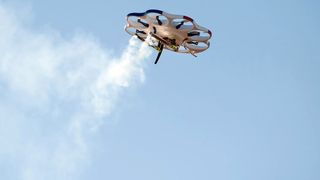Robots will soon control the weather
Cloud seeding drones are in the air

Engineers and meteorologists from Nevada have joined forces to create the first autonomous cloud seeding platform - using drones to control the weather.
Cloud seeding is a technique where small particles are dropped into a cloud from an aircraft or rocket to alter the microphysical processes going on inside and make it rain (or snow).
Research on the subject has been ongoing for more than a century, but it's still not clear how well it actually works in reality - a cloud might produce rain after being seeded, but it's hard to know if that cloud would have just produced rain anyway.
Despite the lack of evidence of its effectiveness, the promise of weather control has lead to a lot of cash being pumped into various cloud seeding schemes. The most famous attempt was probably in 2008 during the Summer Olympics, when China attempted to use cloud seeding to ensure that clouds dropped their rain before passing over the opening and closing ceremonies.
Major Milestone
Now, drone engineers and scientists from the Desert Research Institute, Drone America, and AviSight have joined forces to build a UAV that can carry cloud-seeding equipment. They used a DAx8 drone, which can carry heavier payloads thanks to its eight rotors, and successfully completed flare tests in late January 2016.
"This is a major milestone," said Adam Watts from the Desert Research Institute, who led the project. "Utilizing our state's FAA test site designation, we were able to fly this advanced aircraft right here in Northern Nevada and verify that UAS are fully capable of carrying active cloud seeding payloads."
Mike Richards, CEO of Drone America, added: We are extremely excited to have completed yet another step in reaching our goal of autonomous cloud seeding application.
Get daily insight, inspiration and deals in your inbox
Get the hottest deals available in your inbox plus news, reviews, opinion, analysis and more from the TechRadar team.
Our joint research program with DRI is well on its way to revolutionizing the cloud seeding industry by providing safe airborne seeding with significant potential of providing relief to people in drought-stricken areas."
Most Popular


